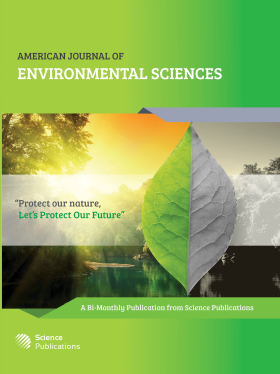Adsorption Study of Several Hydrophobic Organic Contaminants on an Aquifer Material
Abstract
Problem statement: Aim of the present research was to determine coefficient of partition KD between soil and groundwater for five hydrophobic organic pollutants (benzene, chlorobenzene, trichloroethylene-TCE, perchloroethylene-PCE and toluene) in an Italian aquifer material characterized by a low organic carbon content (fOC = 0.00262) by means of laboratory batch tests. Initial aqueous concentrations (quite different among the five compounds) were representative of the pollution level of considered site. Approach: Adsorption data for five afore mentioned compounds were obtained by means of laboratory tests: Multi-contaminant adsorption tests were performed putting in contact 50 g of dried soil together with 200 mL of a contaminant solution for 72 h in order to achieve the equilibrium. After 72 h, supernatant was then analyzed by means of headspace gaschromatography providing the equilibrium concentration of the contaminants of interest in liquid phase. The concentration of contaminants of interest in solid phase (adsorbent) was determined taking advantage of a mass balance performed on each contaminant. Results: Results showed that both linear isotherm (in form of Henry isotherm) and Freundlich isotherm were able to fit experimental points for benzene, chlorobenzene, TCE and PCE in a satisfactory way; as for these four contaminants, PCE is more strongly adsorbed than TCE and TCE, in its turn, is more strongly adsorbed than benzene and chlorobenzene. On the other hand, Langmuir model appeared to be the most suitable in fitting toluene experimental points. The comparison between real distribution coefficient KD obtained fitting experimental points with an Henry-type isotherm and KD obtained on grounds of a theoretical model, like Linear Free Energy Relationships (LFER-based model), showed that LFER model uniformly underestimate the sorption process over whole concentration range, with the only exception of toluene. In case of toluene, LFER-based model fitted the sorption data very well; besides, Henry-type KD is very close to that calculated from LFER correlation over the tested concentration range: Difference between two KD values is the smallest among five considered contaminants (KD toluene theoretical LFER = 0.520 L kg-1; KD toluene experimental = 0.465 L kg-1). Conclusion: The important practical implication of results came from batch tests was that the calculation of KD based on theoretical models, like LFER, may give a wrong sorption estimation in some aquifers with a relatively low fOC content.
DOI: https://doi.org/10.3844/ajessp.2009.508.516

- 5,835 Views
- 6,111 Downloads
- 30 Citations
Download
Keywords
- Hydrophobic Organic Contaminants (HOCs)
- sorption isotherms
- low organic carbon content
- LFER model
